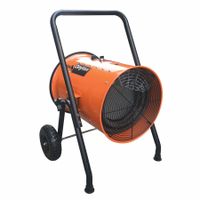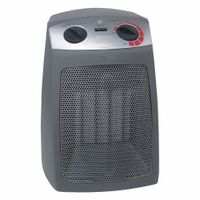Call +(254) 703 030 000 / 751 483 999 / 721 704 777
- Home
- Hvac And Refrigeration
- Heaters
- Electric Heaters
- Portable Electric Heaters
.....Read More
Frequently Asked Questions
1. What is the most energy-efficient portable electric heater?
The most energy-efficient portable electric heater is typically a ceramic heater with a thermostat and oscillation feature. Ceramic heaters are known for their ability to heat up quickly and maintain a consistent temperature, which makes them highly efficient. They use ceramic plates and aluminum baffles to produce heat, and a fan helps distribute the warm air throughout the room.
Key features that enhance energy efficiency in these heaters include:
1. **Thermostat Control**: This allows the heater to maintain a set temperature, reducing energy consumption by turning off the heating element once the desired temperature is reached.
2. **Oscillation**: This feature helps distribute heat more evenly across a room, ensuring that the heater doesn't have to work as hard to maintain a consistent temperature.
3. **Eco Mode**: Some models come with an eco mode that automatically adjusts the power settings to use the least amount of energy necessary to maintain comfort.
4. **Timer Function**: A programmable timer can help reduce energy usage by allowing the heater to operate only when needed.
5. **Safety Features**: Overheat protection and tip-over switches not only enhance safety but also prevent unnecessary energy use by shutting off the heater in unsafe conditions.
6. **Compact Design**: Portable heaters with a compact design are generally more efficient for small spaces, as they require less energy to heat a smaller area.
When choosing a portable electric heater, look for models with the Energy Star label or those that specify energy-efficient features. Brands like Lasko, DeLonghi, and Dyson offer models that are well-regarded for their energy efficiency. Always consider the size of the space you need to heat and choose a heater with an appropriate wattage to avoid wasting energy.
2. Are portable electric heaters safe to use overnight?
Portable electric heaters can be safe to use overnight if certain precautions are taken. However, they do pose potential risks such as fire hazards and carbon monoxide poisoning (in the case of fuel-burning heaters). To ensure safety, follow these guidelines:
1. **Certification**: Use heaters that are certified by recognized testing laboratories like UL, ETL, or CSA, which ensures they meet safety standards.
2. **Placement**: Position the heater on a flat, stable surface away from flammable materials such as curtains, bedding, and furniture. Maintain at least a three-foot clearance around the heater.
3. **Automatic Shut-off**: Choose heaters with an automatic shut-off feature that activates if the heater tips over or overheats.
4. **Timer and Thermostat**: Use heaters with a timer or thermostat to prevent them from running continuously, reducing the risk of overheating.
5. **Unplugging**: When not in use, unplug the heater to prevent electrical fires.
6. **Avoid Extension Cords**: Plug the heater directly into a wall outlet. Using extension cords or power strips can lead to overheating and fire.
7. **Supervision**: Ideally, avoid leaving heaters unattended for long periods. If used overnight, ensure the heater is in good working condition and follow all safety instructions.
8. **Smoke Alarms**: Ensure smoke alarms are installed and functioning properly in the area where the heater is used.
9. **Ventilation**: For fuel-burning heaters, ensure proper ventilation to prevent carbon monoxide buildup.
10. **Regular Maintenance**: Regularly inspect and maintain the heater to ensure it operates safely.
By adhering to these safety measures, the risk associated with using portable electric heaters overnight can be minimized, making them a safer option for maintaining warmth during cold nights.
3. How much does it cost to run a portable electric heater?
To calculate the cost of running a portable electric heater, you need to know the heater's power rating in kilowatts (kW), the number of hours it runs, and the cost of electricity per kilowatt-hour (kWh).
1. **Power Rating**: Most portable electric heaters have a power rating between 1.5 kW and 3 kW. Check the label on your heater for its specific power rating.
2. **Usage Time**: Determine how many hours per day you plan to use the heater.
3. **Electricity Cost**: Find out the cost per kWh from your electricity bill. The average cost in the U.S. is about $0.13 per kWh, but this can vary.
**Calculation**:
- Multiply the heater's power rating by the number of hours it runs to get the total kWh used.
- Multiply the total kWh by the cost per kWh to get the total cost.
**Example**:
- Heater Power: 1.5 kW
- Usage: 5 hours per day
- Electricity Cost: $0.13 per kWh
Total kWh per day = 1.5 kW * 5 hours = 7.5 kWh
Daily Cost = 7.5 kWh * $0.13 = $0.975
Monthly Cost (assuming 30 days) = $0.975 * 30 = $29.25
Therefore, running a 1.5 kW heater for 5 hours a day at $0.13 per kWh would cost approximately $29.25 per month. Adjust the figures based on your specific heater's power rating, usage, and local electricity rates.
4. What size portable electric heater do I need for my room?
To determine the appropriate size of a portable electric heater for your room, you need to consider the room's square footage and the heater's wattage. A general rule of thumb is that you need approximately 10 watts of heating power for every square foot of space.
1. **Measure the Room**: Calculate the square footage by multiplying the room's length by its width. For example, a room that is 12 feet by 15 feet is 180 square feet.
2. **Calculate Required Wattage**: Multiply the room's square footage by 10 watts. For a 180-square-foot room, you would need a heater with at least 1,800 watts.
3. **Consider Ceiling Height**: If your ceiling is higher than the standard 8 feet, you may need a more powerful heater. Add 25% more wattage for each additional foot of ceiling height.
4. **Insulation and Climate**: Poor insulation or a colder climate may require a heater with higher wattage. Conversely, a well-insulated room in a milder climate might need less.
5. **Heater Types**: Choose between different types of heaters like convection, radiant, or fan-forced, depending on your needs. Convection heaters are good for whole-room heating, while radiant heaters are better for spot heating.
6. **Safety Features**: Ensure the heater has safety features like tip-over protection and overheat protection.
7. **Energy Efficiency**: Look for energy-efficient models to save on electricity bills.
8. **Portability and Size**: Ensure the heater is easy to move and fits well in your space without obstructing movement.
By considering these factors, you can select a heater that efficiently warms your room while ensuring safety and energy efficiency.
5. Can portable electric heaters be used in bathrooms?
Yes, portable electric heaters can be used in bathrooms, but with caution and adherence to safety guidelines. Bathrooms are high-moisture environments, which increases the risk of electric shock. Therefore, it is crucial to select a heater specifically designed for bathroom use, often labeled as "splash-proof" or "suitable for bathroom use." These heaters typically have an IP (Ingress Protection) rating, indicating their resistance to water and moisture.
When using a portable electric heater in a bathroom, ensure it is placed away from water sources like sinks, bathtubs, and showers to prevent accidental splashing. The heater should be positioned on a stable, dry surface to avoid tipping over. Additionally, it is advisable to use a heater with a built-in tip-over switch and overheat protection for added safety.
Ensure the heater is plugged into a GFCI (Ground Fault Circuit Interrupter) outlet, which will cut off the power if it detects an electrical fault, reducing the risk of electric shock. Avoid using extension cords, as they can pose a tripping hazard and may not be rated for the heater's power requirements.
Always follow the manufacturer's instructions and safety warnings. Never leave the heater unattended while in use, and turn it off when leaving the bathroom. Regularly inspect the heater for any signs of damage or wear, such as frayed cords or cracks in the casing, and discontinue use if any issues are found.
In summary, while portable electric heaters can be used in bathrooms, it is essential to choose the right type and follow safety precautions to minimize risks associated with electricity and moisture.
6. How do I maintain and clean a portable electric heater?
1. **Unplug and Cool Down**: Always unplug the heater and let it cool completely before cleaning to ensure safety.
2. **Surface Cleaning**: Use a soft, damp cloth to wipe the exterior. Avoid using abrasive cleaners or solvents that might damage the surface.
3. **Dust Removal**: Use a vacuum cleaner with a brush attachment to remove dust from vents and grills. This helps maintain airflow and efficiency.
4. **Filter Cleaning**: If your heater has a filter, remove it and clean it according to the manufacturer's instructions. Typically, this involves rinsing it with water and allowing it to dry completely before reinserting.
5. **Internal Cleaning**: For deeper cleaning, carefully open the heater if the design allows. Use compressed air to blow out dust from internal components. Be cautious not to damage any parts.
6. **Check for Damage**: Inspect the power cord and plug for any signs of wear or damage. Replace if necessary to prevent electrical hazards.
7. **Reassemble and Test**: Once cleaned, reassemble any parts you may have removed. Plug the heater back in and test it to ensure it operates correctly.
8. **Regular Maintenance**: Perform these cleaning steps regularly, especially before and after the heating season, to ensure optimal performance and longevity.
9. **Storage**: When not in use, store the heater in a dry, dust-free environment to prevent damage and dust accumulation.
10. **Follow Manufacturer’s Instructions**: Always refer to the user manual for specific cleaning and maintenance guidelines tailored to your heater model.
7. What are the best portable electric heaters for large spaces?
1. **Dr. Infrared Heater Portable Space Heater**: Known for its dual heating system combining infrared and convection heat, it efficiently warms large spaces. It features a 12-hour automatic shut-off timer, remote control, and a quiet blower.
2. **De'Longhi Oil-Filled Radiator Space Heater**: This oil-filled radiator is ideal for large rooms due to its long-lasting heat retention. It operates silently and includes an adjustable thermostat, multiple heat settings, and a thermal shut-off to prevent overheating.
3. **Dyson Hot + Cool Jet Focus AM09 Fan Heater**: This versatile heater offers both heating and cooling functions. It uses Air Multiplier technology for even heat distribution and has a precise thermostat to maintain the desired temperature.
4. **Lasko 755320 Ceramic Space Heater**: Featuring widespread oscillation, this ceramic heater is effective for large areas. It includes a digital display, remote control, and an adjustable thermostat with two heat settings.
5. **Vornado AVH10 Vortex Heater**: Utilizing Vortex technology, this heater circulates warm air throughout the room. It has an automatic climate control feature, multiple heat settings, and safety features like tip-over protection.
6. **Heat Storm HS-1500-PHX-WIFI Infrared Heater**: This wall-mounted heater is Wi-Fi enabled, allowing control via a smartphone app. It uses infrared technology to heat large spaces efficiently and includes a safe-to-touch grill.
7. **Cadet Com-Pak Twin 4000W Heater**: Designed for large areas, this wall heater offers powerful heating with a built-in thermostat. It features a dual-fan system for quick heat distribution and is ideal for supplemental heating.
8. **Dyna-Glo 30,000 BTU Liquid Propane Blue Flame Heater**: Suitable for large spaces, this propane heater provides significant heat output. It includes a thermostat control knob and can be wall-mounted or used with a base.


